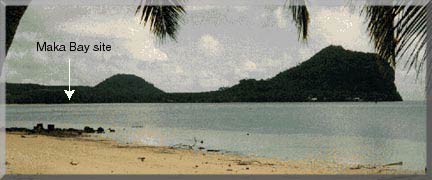Archaeology on RotumaDuring a six-week period in 1996, Thegn Ladefoged of Auckland University and his student Jonathan Wall conducted archaeological research on Rotuma, with the goal of finding an early site to shed light on early Rotuman prehistory. They excavated an area of 12 square meters at Sovaea in Itu'muta District. The site, which the researchers named Maka Bay after the adjacent lagoon, is located next to Jiare Vafo'ou's house approximately thirty metres inland of the high tide mark.  The researchers divided the strata in the site into three intact prehistoric cultural layers. The top layer was a disturbed layer, approximately 15 cm thick, which contained metal fragments and other historic artifacts. Below this sediment was an intact cultural layer which extended from about 15 cm to a maximum depth of about 50 cm below the ground surface. This layer contained faunal remains, Tridacna (giant clam) shell adzes and shell ornaments, and seven ceramic sherds, including two exotic (not from local material) pottery sherds, one of which is paddle-impressed. A charcoal sample from a depth of 30 to 40 cm below ground surface produced a conventional radiocarbon age of 1050 +/- 50 years ago. The middle cultural layer extended from about 50 to 70 cm below ground surface. It contained a number of hearths, postholes, pits, artefacts, and considerable faunal remains. Two pottery sherds were recovered from the layer, including one rim sherd with faint paddle-impressed banding. The lower cultural layer extended from about 70 cm to a maximum depth of about 100 cm below the ground surface with the bottom of the layer defined by a sterile clay sediment. A rat femur from a depth of 88 to 98 cm below ground surface produced a conventional radiocarbon age of 1400 +/- 40 years ago and an associated charcoal sample yielded a conventional radiocarbon age of 1290 +/- 60 years ago. Excavation exposed a number of features in the cultural layer including hearths, postholes, and midden concentrations. Artefacts associated with the layer include Tridacna shell adzes, shell ornaments and tools, hammer and grinding stones, and 13 ceramic sherds. A large faunal collection was also recovered from the layer. In his Master's thesis (Auckland University) based on this research, Jonathan Wall argues that the results indicate that Rotuman artefact types resemble those of West Polynesia more closely than those of eastern Melanesia. Further indication of contact with West Polynesia is provided by temper analysis of excavated Maka Bay pottery sherds, which appears to indicate contact with Fiji about A.D. 1000. He also concludes that the Maka Bay inhabitants relied on inshore marine exploitation, supplemented by benthic (ocean floor) and pelagic (ocean surface) exploitation during the middle of the first millennium A.D., after which there was an increase in agricultural gardening. A paper reporting on the results of the research is scheduled to appear in the Journal of the Polynesian Society, Volume 107(3), 1998. It is entitled "Exotic and Indigenous: Ceramic Sherds from the Island of Rotuma," and is co-authored by Thegn N. Ladefoged, Jonathan Wall, Philippa Black, and William R. Dickinson. |